Table of Contents.
Bomb Attack Against
Hitler, 1944.
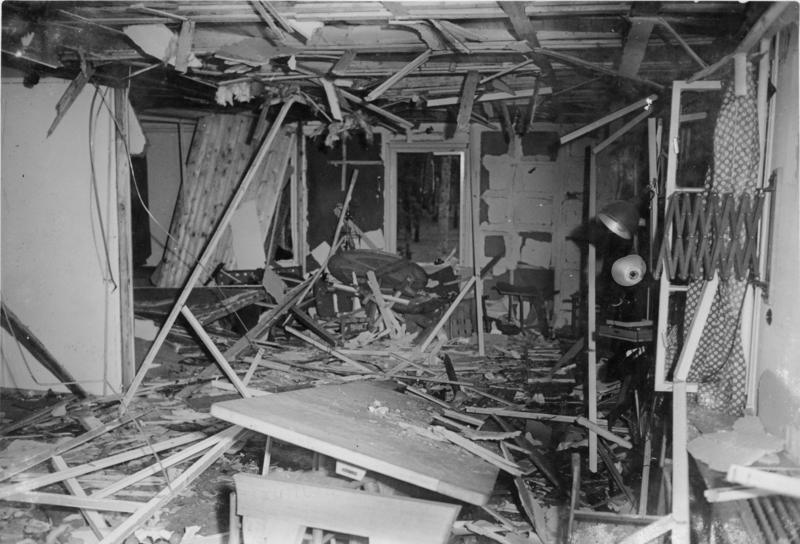
On July 20, 1944, at 12:42 p.m., Hitler and his staff were in
this conference room when a time bomb exploded.
In the foreground is the conference table and one of its table legs
underneath. It was one such table leg that
saved Hitler.
Background.
The Battle of Stalingrad took place from August 21, 1942 to February 2,
1943. This clash between the Soviet Union and Germany was a severe
setback for the Nazis. The Soviet forces managed to pin the German 6th
Army in Stalingrad in a pincer movement. A total of around 290,000
troups were trapped. Cold, famine and disease greatly reduced the
troups. When they surrendered on February 2, 1943, 91,000 men remained.
This event has been described by historians as the turning point in
World War II.
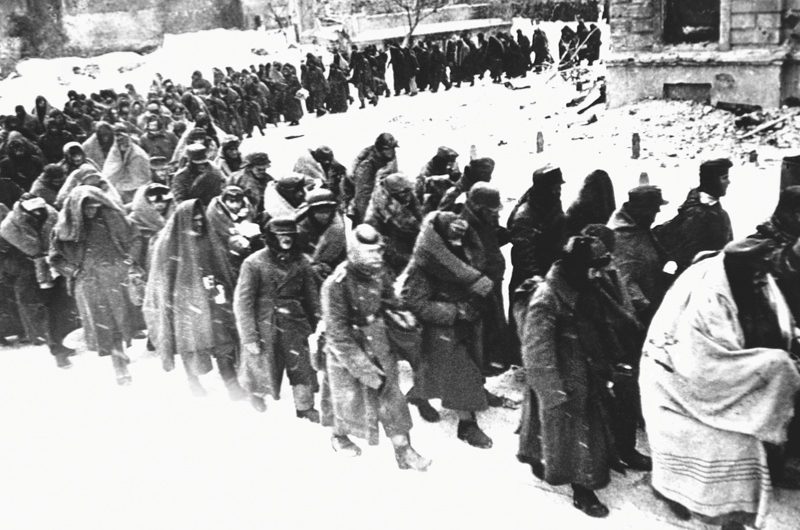
Stalingrad. The German 6th Army has surrendered.
In Berlin, discontent grew within the German officer corps. It had been
realized that it was only a matter of time before Germany would
surrender. Groups emerged that had the goal of saving the country from
disaster. They wanted to avoid a Soviet occupation. The plan was to
recruit senior officers and other key people to carry out a coup d'état
after Hitler was eliminated. After that, negotiations with the Western
powers about capitulation would begin. Some of the leading figures were:
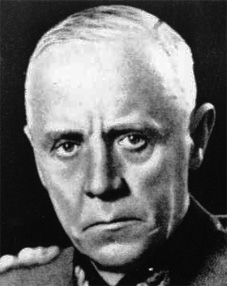
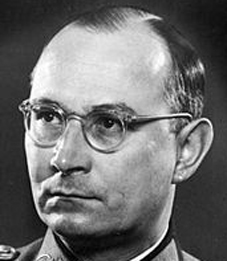
Ludwig Beck, Colonel General.
Friedrich Olbricht, General.
(1880 – 1944)
(1888 - 1944)
Assassination plans.
Ever since 1938 there had been plans to eliminate Hitler but they had
always failed. It was groups within the German army and military
intelligence that were behind these attempts. During 1942, a new group
was formed for the resistance to Hitler. It was led by Henning
von Tresckow.
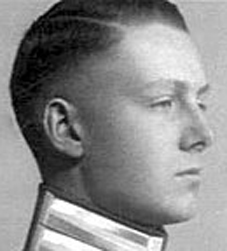

Henning von
Tresckow
Ernest Louis I, Grand Duke
(1901- 1944)
of Hesse and by Rhine
(1868 - 1937)
He was a Colonel in the army. Together with Major General Hans Oster, he
managed to build up a network for the resistance to Hitler. One of the
most important recruits was General Friedrich Olbricht.
He was the head of the army headquarters Bendlerblock in Berlin (
52°30'28"N 13°21'44"E ). Common to many of
them was that they belonged to the aristocratic elite. There were people
who helped Hitler to power in the 1930s but who had now had enough of
the Nazi madness. They disliked the treatment of prisoners of war and
the widespread slavery that existed in Germany's industry. Millions of
people had been taken from the occupied countries to be enslaved in
Germany. The conspirators were not interested in a democratization of
Germany. It was rather that they attacked the Nazis from the right. They
wanted to regain the position of power they had before the Nazis took
over.
Claus von Stauffenberg.
Henning von Tresckow met Claus von
Stauffenberg for the first time in
August 1943. Stauffenberg held the position of Colonel in the army's
General Staff. It gave him the right to participate in the conferences
conducted by the staff and led by Hitler. Stauffenberg was placed at the
Benderblock headquarters.
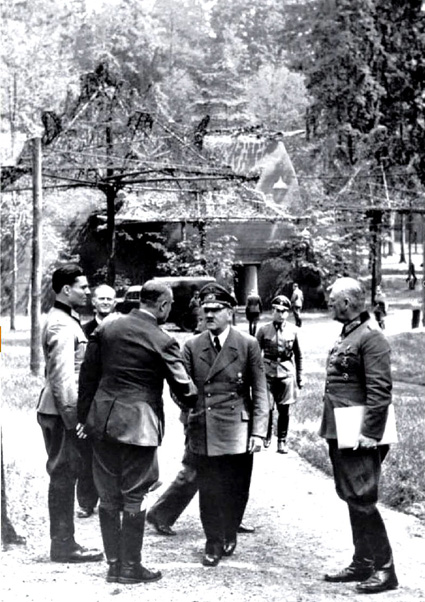
Hitler greets conference participants on July 15, 1944.
Stauffenberg on the far left.
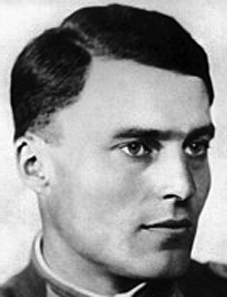

Claus von Stauffenberg.
Ernest Louis I, Grand Duke
(1907 - ????)
of Hesse and by Rhine
(1868 - 1937)
Stauffenberg was born and raised at Stauffenberg Castle, Jettinge (
48º30'04.20”N 8º01'40.17”E ). His father,
Alfred Schenk Graf von Stauffenberg, was the last Court Marshal
of the Duchy of Württemberg. Claus von Stauffenberg was well educated.
He was a devout Catholic. During 1943 he was stationed in Tunisia. On
April 7, 1943, he traveled in a military column. Suddenly the column was
attacked by American aircraft. Stauffenberg was seriously injured. He
lost his left eye and two fingers on his left hand. Stauffenberg had no
qualms about the planned assassination attempt on Hitler - which he let
Tresckow understand. When Tresckow was later placed on the Eastern
Front, Stauffenberg took over responsibility for planning and executing
the attack.
The Wolf's Lair.
The Wolf's Lair was an approximately 3 km² area with underground
bunkers. The area was defended with barbed wire barriers, minefields and
anti-aircraft guns. The facility was the most important headquarters for
the Nazis during World War II. It is located near the town of Rastenburg
in northeastern Poland ( 54°4′49.44″N, 21°29′38.76″E ). In Rastenburg
there was an airfield which facilitated communications to Berlin. Hitler
stayed in The Wolf's Lair for most of the war. Other leading Nazis such
as Göring and Himmler also had their own bunkers in the area.
The assassination attempt.
The conspirators had considered many conceivable possibilities to
eliminate Hitler. He was constantly well guarded. There was no
possibility of letting a suicide bomber approach Hitler and then
detonate a bomb. Poisoning was considered. The problem here was that
Hitler was a vegetarian. He was served dishes that were prepared
according to his own special wishes. It was judged that he would
immediately notice if there was a mixture of poison in the food.
Finally, they decided on a bomb attack in the Wolf's Lair. Stauffenberg
was the one to place the bomb.
On July 20, 1944, the General Staff had scheduled a conference in the
Wolf's Lair. Stauffenberg was called to participate. He flew up from
Berlin to Rastenburg in the morning. With him in his luggage was a
briefcase containing an explosive charge. A pencil
detonator had been
inserted into 1 kg of plastic explosives.

Pencil Detonator.
A glass container is visible on the far right. When crushed using the
screw (far right), a corrosive liquid (copper chloride) flows out. The
steel wire that holds the firing pin in place corroded off. A spring
pushes the firing pin against the firing cap (far left). When the firing
cap detonates, the plastic explosives also detonates. The pen detonator
used by Stauffenberg was designed to go off after 10 minutes.
The conference started at 12:30. It had been moved to a barracks that
was above ground. A total of 25 people participated.
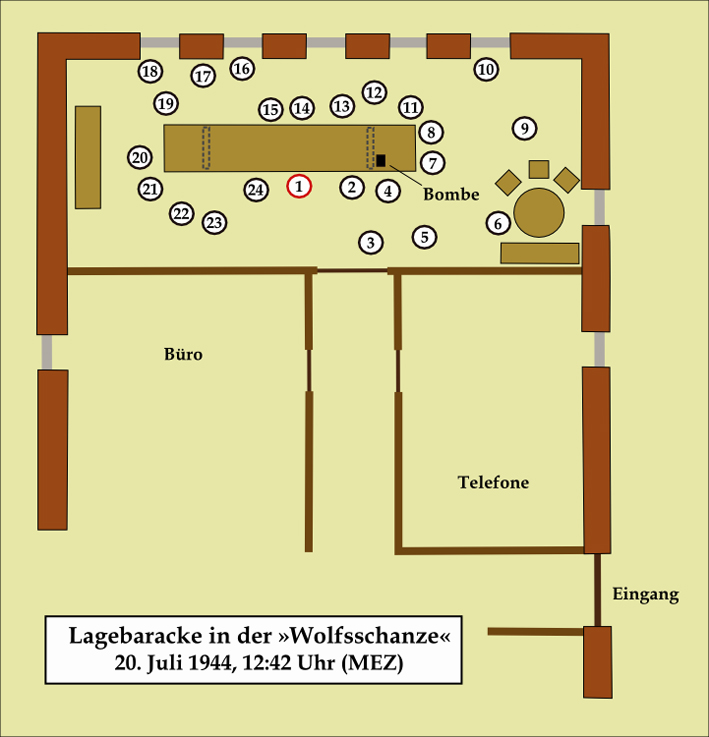
Sketch of the conference room. The numbering shows the location
of the participants at the
conference table. The dimensions of the table were 5.5 X 1.5 m. Source:
Wikipedia.
1 = Hitler
4 = Heinz Brandt
Stauffenberg's location is not specified. After he planted the bomb, he
received a scheduled phone call. He then left the conference room. He
had placed the bomb on the left side of the table leg but Heinz Brandt
thought the briefcase was in the way of his feet. He then sweeped the
briefcase with his foot to the right side of the table leg. Stauffenberg
awaited the detonation outside the barracks. When it occurred, at 12:42,
he was convinced that Hitler had been eliminated. It turned out after a
few hours that four people had died. They had positions 11, 7, 4, and 3.
At least 20 people were injured. Hitler escaped with minor injuries.
Ruptured eardrums and burns on the legs. That Hitler survived was
thought to be due to the bomb being on the right side of the table leg.
Stauffenberg and his adjutant drove immediately after the detonation to
Rastenburg Airport. A plane was waiting there to take them to Berlin.
Upon arriving at Bendlerblock, they were informed that Hitler had
survived the attack. It meant that it was futile to try to complete the
last phase of the operation, i.e. the coup d'état.
The conspirators were quickly captured. They were sentenced to death in
summary trials. Stauffenberg and Olbricht were executed by a firing
squad in the War Department's courtyard at 11 pm on 20 July 1944 (
52°30'28"N 13°21'44"E ). Eight other conspirators were
executed by hanging on 8 August 1944.
My comment on the above.
The bombing of Hitler on 20 July 1944 was a False Flag operation. At
that time, the German forces were under heavy pressure from the Allies.
The Soviet Union advanced steadily in the east. The United States and
Great Britain had landed in Normandy on June 6, 1944 (Operation
Overlord). The purpose of the "bombing" was to strengthen Hitler's
position as a "survivor". In the section
Hitler's escape to Argentina,
I claim that Hitler and those closest to him started Operation Gray
Wolf, i.e. the plans for settlement in Argentina as early as 1943.
After the surrender in Stalingrad, Hitler and all the leading military
knew that it was only a matter of time before Germany would surrender.
The "bomb attack" was a measure aimed at strengthening public opinion at
home. The Nazis were able to gain time for the continued planning of the
escape to Argentina.
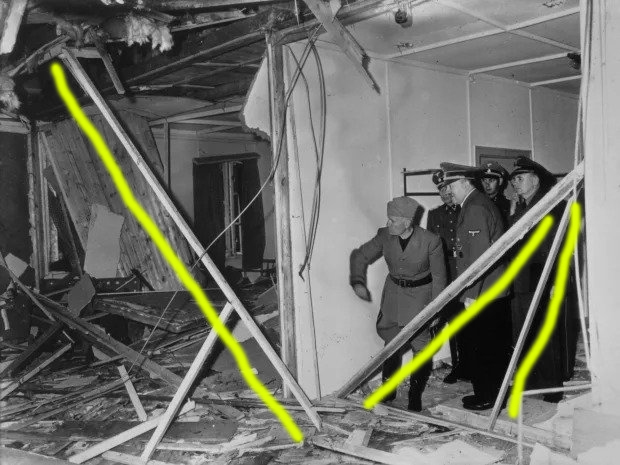
Hitler and Mussolini inspect the damage after the "bomb attack".
V-marked.
As the operation was designed, there was no reason to place the
"assassination" in the Wolf's Lair. There were hardly any barracks above
ground within the area. It is likely that they blew up a barrack
somewhere on the outskirts of Berlin. Any visitors who were interested
in seeing the devastation could then easily go out to the "attack site"
to be photographed. Not a single person was injured in the "attack". It
is absolutely certain that an explosive charge was set off in the room.
If you used 1 kg of plastic explosives, it is more than enough to cause
the devastation shown in the pictures. If any human was in the premises,
the chances of survival were very small.
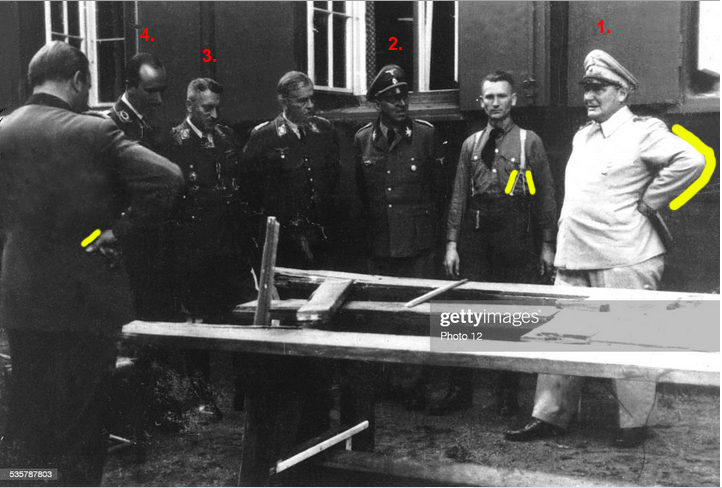
Inspection of the "exploded" table. 1 = Hermann Goering, 2 =
Julius Schaub, 3 = Karl Koller,
4 = Hermann Fegelein. Three of them perform V-marking.
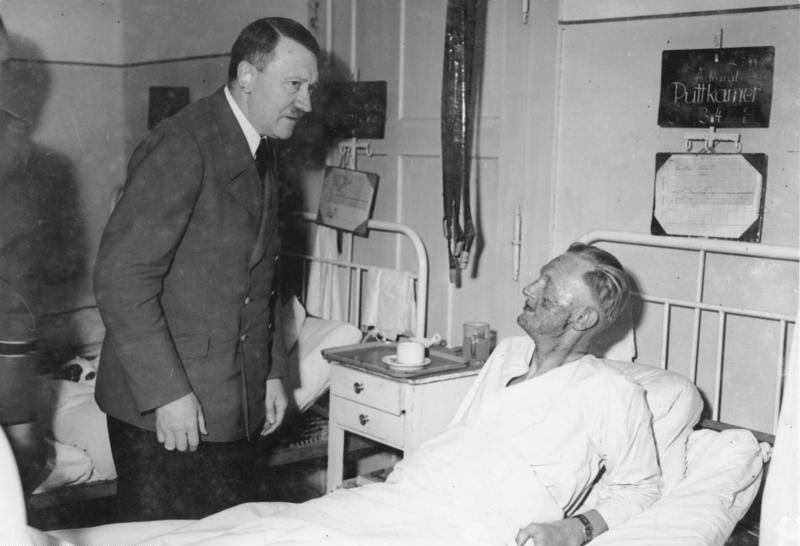
Hitler and Karl-Jesko von Puttkamer.
At the end of July 1944, Hitler visited one of the "victims" of the
attack, Karl-Jesko von Puttkamer. He is said to be
admitted to Carlshof Hospital, Karolewo, Poland. He allegedly had
position 10 at the conference table. He appears to have suffered facial
injuries in the detonation. It's makeup. Hitler has a cotton ball in his
right ear. He marks in this way that his eardrums have been damaged. His
face is unharmed. The claim that Hitler escaped with minor injuries
because a table leg "shielded" the bomb is preposterous. The alleged
explosive charge would have made wood chips of the table leg. Hitler
would have had no chance.
My assumption is that all the alleged participants in the operation are
made up. No one has been executed. When it comes to Claus von
Stauffenberg, I have the following hypothesis:
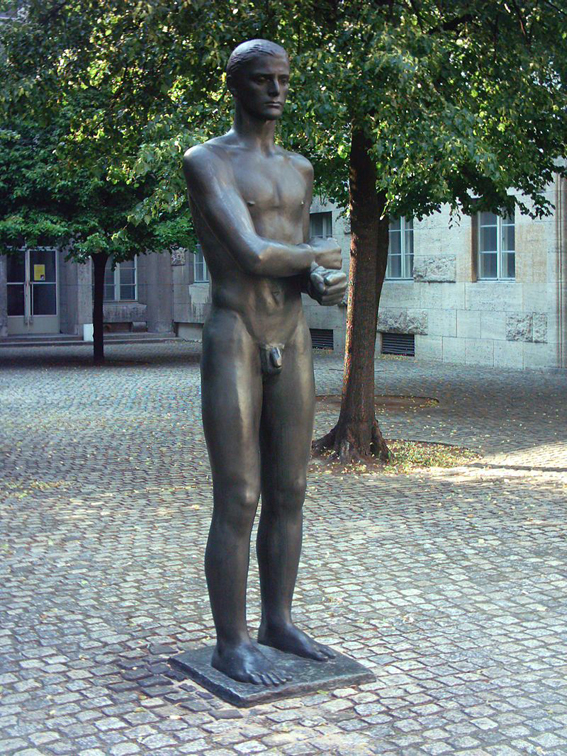
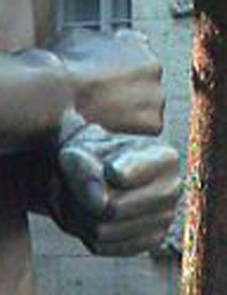
The above statue is supposed to represent Claus von Stauffenberg. It is
located in the former Ministry of War's, Bendlerblock, courtyard (
52°30'28"N 13°21'44"E ). The statue is anonymous where
it stands. No names.
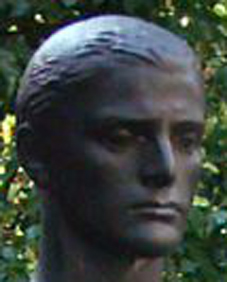

Claus von Stauffenberg, statue. Claus
von Stauffenberg.
That a Nazi is honored in this way in Germany is remarkable. My
assumption is that Stauffenberg was a semen donor to Jehovah's. He
belonged to the absolute highest stratum of the German aristocracy. Of
course, there was no way to eliminate such a person. He may have been an
unwanted donor due to his biological origin. The "bomb attack" became an
opportune moment to let Stauffenberg disappear from the market. It is
alleged that he was injured during his service in Tunisia. I have not
been able to find any photos to prove this claim. It is likely that
Stauffenberg, like many other prominent Nazis, moved his residence to
Argentina.